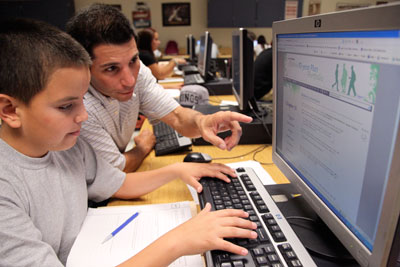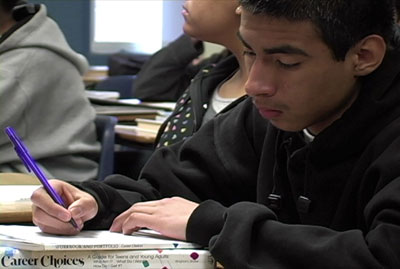
Home
K12 SWP & GFSF
GFSF Overview
9th Grade
10th - 12th
College
Dual Enrollment
Professional Development
Research7th-8th
Contact
What is the Career Choices Curriculum and why is it successful?
 According to the Gallup Student Poll National Report, only 50% of American students in grades 5 through 12 are actively engaged in school and hopeful about their future. We clearly need
to embrace more innovative and effective ways to enhance students' confidence in themselves and the power of education.
According to the Gallup Student Poll National Report, only 50% of American students in grades 5 through 12 are actively engaged in school and hopeful about their future. We clearly need
to embrace more innovative and effective ways to enhance students' confidence in themselves and the power of education.Career Choices is an interdisciplinary curriculum that involves students and teachers in an interactive learning process. What makes the Career Choices curriculum unique and effective? Simply, it is an academically-based curriculum-repackaged in a thematic format to address the developmental needs of the early adolescent. How?
- It teaches a critical-decision making process for life-defining decisions
- It culminates in a 10-year Career & Education Plan that help young people envision a productive life of their own choosing
- It answers a pressing and crucial question: Why do I need a good education?
- It is different by design to be less threatening for all students
- It melds "high tech" with "high touch," which is so important to student buy-in of the content and concepts presented.
Whether students are headed for an Ivy League college or an entry-level job, they all crave a clear sense of direction in their lives. Based on research and a strong belief that all students deserve an excellent education, Career Choices guides students through a crucial self-discovery process and transforms them into self-motivated learners. Students develop knowledge, skills, and attitudes to successfully examine their own lives, evaluate a wide range of educational options, explore career and life paths, and establish reasoned and researched goals for their future.
Students in the 8th or 9th grade enroll in a semester or year-long course where they engage in the process of answering these fundamental questions: 1) Who am I? 2) What do I want? and 3) How do I get it? These three questions drive the curriculum to make it relevant, rigorous, and effective at increasing engagement and motivation. In addition the curriculum offers the opportunity to integrate the optional English and math texts along with online enhancements. The course culminates with students developing an individualized, online 10-year plan that charts their journey through high school and post-secondary education or training and into the workforce.
 Students revisit their 10-year plans in each of their academic classes during the 10th, 11th, and 12th grades to maintain motivation and direction. Instructors can use students' individualized
online 10-year plans as a tool to inform advisory and academic coaching functions, constantly motivating students to graduate and reach the goals that will lead to an economically selfsufficient
adulthood.
Students revisit their 10-year plans in each of their academic classes during the 10th, 11th, and 12th grades to maintain motivation and direction. Instructors can use students' individualized
online 10-year plans as a tool to inform advisory and academic coaching functions, constantly motivating students to graduate and reach the goals that will lead to an economically selfsufficient
adulthood.Career Choices aligns with The George Washington University's Freshman Transition Initiative whole-school redesign model and its accompanying set of standards as well as the U.S. Department of Education's six recommendations for successful dropout prevention programs.
When young people have a productive vision of their future, (that matches their goals, identity, aptitudes, personalities, lifestyle expectations and passions) along with a quantitative 10- year plan of their own making, the value of applying themselves to their education becomes abundantly clear. The process taught in this standards-based course, quantifies the reason to learn.

| MediaCareers | ||
|
Partners or collaborators
Foundation for California Community Colleges George Washington University’s Freshman Transition Initiative California Community College Chancellor's Task Force on Student Success Academic Innovations LLC UCSB Graduate School of Education California Dropout Research Project UC Educational Evaluation Center, Gevirtz Graduate School of Education | Eastern Oregon University’s College of Education California SB1070 Coordinators from select regions Santa Barbara Foundation Santa Barbara City College Dual Enrollment Department Carpinteria and Santa Barbara Unified School Districts Santa Barbara County Office of Education’s Partners in Education | |